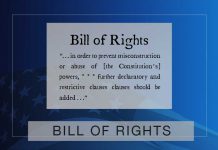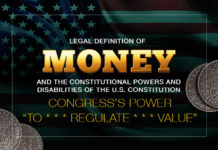Last Updated on October 1, 2021 by Constitutional Militia
Coinage Act of 1792
In this Act, Congress followed common-law tradition by continuing the use of silver, gold, and copper as “Money”.[1] It reiterated the judgment of the Continental Congress and the Constitution that “the money of account of the United States shall be expressed in dollars or units,”[2] and defined the “DOLLARS OR UNITS” in terms of weight, as “of the value of a Spanish milled dollar as the same is now current, and to contain three hundred and seventy-one grains and four sixteenth parts of a grain of pure * * * silver.”[3]
No “Gold Dollar” or “Gold Standard” Established
The Coinage Act of 1792
The Coinage Act of 1792[4] initiated a new statutory system, embodying the common-law and constitutional principles Hamilton had reaffirmed in his Report. Congress followed common-law tradition by continuing the use of silver, gold, and copper as “Money”.[5] It reiterated the judgment of the Continental Congress and the Constitution that “the money of account of the United States shall be expressed in dollars or units,”[6] and defined the “DOLLARS OR UNITS” in terms of weight, as “of the value of a Spanish milled dollar as the same is now current, and to contain three hundred and seventy-one grains and four sixteenth parts of a grain of pure * * * silver.”[7] Recognizing that to adopt Hamilton’s suggestion of a parallel “gold dollar” would cause confusion, Congress created no such coin, instead mandating the coinage of “EAGLES”, “each to be of the value of ten dollars or units, and to contain two hundred and forty-seven grains and four eighths of a grain of pure * * * gold”,[8] the weight of fine gold then believed equivalent in the market place to 3, 712-½ grains of fine silver. For, following Hamilton’s recommendation, Congress fixed the proportional value of gold to silver in all coins which shall by law be current as money within the United States” at “fifteen to one, according to quantity in weight, of pure gold or pure silver”.[9] And it made all the gold and silver coins * * * issued from the * * * mint * * * a lawful tender in all payments whatsoever, those of full weight according to the respective values * * * declared [in the Act], and those of less than full weight at values proportional to their respective weights”.[10] Congress also provided for “free coinage”: namely that “any person” might
bring to the * * * mint gold and silver bullion, in order to their being coined; and the bullion so brought shall be coined as speedily as may be after the receipt thereof, and that free of expense to the person * * * by whom the same shall have been brought. And as soon as said bullion shall have been coined, the person * * * by whom the same shall have been delivered, shall upon demand receive in lieu thereof coins of the same species of bullion which shall have been delivered, weight to weight, of the pure gold or pure silver therein contained: Provided nevertheless, That it shall be at the option of the party * * * bringing such bullion, and of the director of the * * * mint to make an immediate exchange of coins for standard bullion, with a deduction of one half per cent. From the weight of the pure gold or pure silver contained in the said bullion, as an indemnification the mint for the time which will necessarily be required for coining the said bullion, and for the advance which shall have been so made in coins.[11]
And Congress affixed the penalty of death for debasing the coinage.[12]
This statute is significant in several respects:
In sum, the Coinage Act of 1792 demonstrates an early Congress’s strict adherence to the common-law and constitutional principles elucidated heretofore. Congress coined American “DOLLARS or UNITS” as “Money”, containing the intrinsic value of silver in a constitutional “dollar[ ]”: “a Spanish milled dollar as the same is now current”. It coined American “EAGLES” as “Money” containing a fixed weight of pure gold—and “regulate[d] the[ir] Value” at so-many “DOLLARS” by comparing their intrinsic value in (or weight of) to the market equivalent of coined silver. It gave both silver and gold coins legal-tender character for their intrinsic values in all payments. It opened the mint to “free coinage” of the precious metals. And it outlawed the debasement of the nation’s new “Money”. All this is hardly surprising. For the statesmen who drafted and approved these measures were more than merely conversant with common-law principles, the experiences of the Continental Congress, and the monetary provisions of the Constitution. And their handiwork was more than a merely coincidental embodiment of those principles, experiences, and provisions. Rather, taking into account the vicissitudes of the time, the Coinage Act of 1792 perfectly reflected what the common law and the law under the Articles of Confederation had been before ratification of the Constitution, and what the constitutional law was then and remains today. It definitely interpreted, elaborated, and applied the Constitution—with a clearly constitutional character its own in Section 9 (definition of the “DOLLAR[ ]”), 14 (“free coinage” of silver and gold), 16 (legal-tender character for silver and gold coins), and 20 (“DOLLAR[ ]” identified as “money of account”).[13] In particular, the Congressional determination of the weight of a “DOLLAR[ ]”—“the value of a Spanish milled dollar as the same is now current”[14]—remains for all practical purposes today a statement of constitutional law unalterable except by amendment of the Constitution itself. For, at the remove of almost two centuries, to revise the conclusion that 371-¼ grains of fine silver represents an average of the Spanish “pieces of eight” in circulation in the United States in the years immediately preceding 1792 is most probably impossible.[15]






























